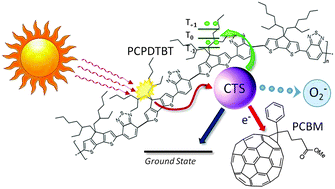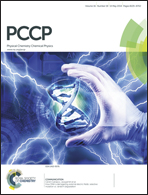The critical role of interfacial dynamics in the stability of organic photovoltaic devices†
Abstract
Understanding the stability and degradation mechanisms of organic solar materials is required to achieve long device lifetimes. Here we study photodegradation mechanisms of the (poly[2,6-(4,4-bis-(2-ethylhexyl)-4H-cyclopenta[2,1-b;3,4-b′]dithiophene)-alt-4,7-(2,1,3-benzothiadiazole)]):[6,6]-phenyl-C61-butyric acid methyl ester (PCPDTBT:PCBM) low band gap-based photovoltaic blend. We apply quasi steady state Photo-induced Absorption Optical Spectroscopy, time-resolved Electron Spin Resonance Spectroscopy and theoretical modeling to investigate the dynamics of long-lived photoexcited species. The role of the interfacial physics in the efficiency and robustness of the photovoltaic blend is clarified. We demonstrate that the polymer triplet state (T), populated through the interfacial charge transfer (CT) state recombination, coexists with charge carriers. However, in contrast to previous suggestions, it has no role in the degradation process caused by air exposure. Instead, the long-lived emissive interfacial CT state is responsible for the blend degradation in air. It mediates direct electron transfer to contaminants, leading to the formation of reactive and harmful species, such as the superoxide.


 Please wait while we load your content...
Please wait while we load your content...